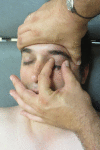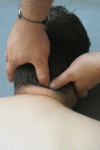Clinical reasoning for manual therapy management of tension type and cervicogenic headache
- PMID: 24976747
- PMCID: PMC4062351
- DOI: 10.1179/2042618613Y.0000000050
Clinical reasoning for manual therapy management of tension type and cervicogenic headache
Abstract
In recent years, there has been an increasing knowledge in the pathogenesis and better management of chronic headaches. Current scientific evidence supports the role of manual therapies in the management of tension type and cervicogenic headache, but the results are still conflicting. These inconsistent results can be related to the fact that maybe not all manual therapies are appropriate for all types of headaches; or maybe not all patients with headache will benefit from manual therapies. There are preliminary data suggesting that patients with a lower degree of sensitization will benefit to a greater extent from manual therapies, although more studies are needed. In fact, there is evidence demonstrating the presence of peripheral and central sensitization in chronic headaches, particularly in tension type. Clinical management of patients with headache needs to extend beyond local tissue-based pathology, to incorporate strategies directed at normalizing central nervous system sensitivity. In such a scenario, this paper exposes some examples of manual therapies for tension type and cervicogenic headache, based on a nociceptive pain rationale, for modulating central nervous system hypersensitivity: trigger point therapy, joint mobilization, joint manipulation, exercise, and cognitive pain approaches.
Keywords: Cervicogenic headache; Manual therapy; Pain; Sensitization; Spine; Tension type headache; Trigger points.
Figures







Similar articles
-
Non-pharmacological management of persistent headaches associated with neck pain: A clinical practice guideline from the Ontario protocol for traffic injury management (OPTIMa) collaboration.Eur J Pain. 2019 Jul;23(6):1051-1070. doi: 10.1002/ejp.1374. Epub 2019 Feb 28. Eur J Pain. 2019. PMID: 30707486 Review.
-
Clinical Reasoning Behind Non-Pharmacological Interventions for the Management of Headaches: A Narrative Literature Review.Int J Environ Res Public Health. 2020 Jun 9;17(11):4126. doi: 10.3390/ijerph17114126. Int J Environ Res Public Health. 2020. PMID: 32527071 Free PMC article. Review.
-
The cervical spine in tension type headache.Musculoskelet Sci Pract. 2023 Aug;66:102780. doi: 10.1016/j.msksp.2023.102780. Epub 2023 May 29. Musculoskelet Sci Pract. 2023. PMID: 37268552
-
Are non-invasive interventions effective for the management of headaches associated with neck pain? An update of the Bone and Joint Decade Task Force on Neck Pain and Its Associated Disorders by the Ontario Protocol for Traffic Injury Management (OPTIMa) Collaboration.Eur Spine J. 2016 Jul;25(7):1971-99. doi: 10.1007/s00586-016-4376-9. Epub 2016 Feb 6. Eur Spine J. 2016. PMID: 26851953
-
Physical therapy for headaches.Cephalalgia. 2016 Oct;36(12):1134-1142. doi: 10.1177/0333102415596445. Epub 2016 Jul 20. Cephalalgia. 2016. PMID: 26660851 Review.
Cited by
-
Head Pain Reproduction and Resolution Behavior in Response to Sustained Mobilization of the Upper Cervical Spine: A Case Series.Arch Physiother. 2025 Jun 20;15:158-164. doi: 10.33393/aop.2025.3340. eCollection 2025 Jan-Dec. Arch Physiother. 2025. PMID: 40567247 Free PMC article.
-
Deep Cervical Muscles and Functionality in Patients with Chronic Tension-Type Headache: An Observational Study.Medicina (Kaunas). 2022 Jul 10;58(7):917. doi: 10.3390/medicina58070917. Medicina (Kaunas). 2022. PMID: 35888636 Free PMC article.
-
Unraveling the challenge of head and face pain.J Man Manip Ther. 2014 Feb;22(1):1. doi: 10.1179/1066981713Z.00000000090. J Man Manip Ther. 2014. PMID: 24976742 Free PMC article. No abstract available.
-
Cervico-cephalalgiaphobia: a subtype of phobia in patients with cervicogenic headache and neck pain? A pilot study.J Man Manip Ther. 2016 Sep;24(4):200-9. doi: 10.1179/2042618615Y.0000000015. J Man Manip Ther. 2016. PMID: 27582619 Free PMC article.
-
Remedial Massage Therapy Interventions Including and Excluding Sternocleidomastoid, Scalene, Temporalis, and Masseter Muscles for Chronic Tension Type Headaches: a Case Series.Int J Ther Massage Bodywork. 2020 Feb 26;13(1):22-31. eCollection 2020 Mar. Int J Ther Massage Bodywork. 2020. PMID: 32133042 Free PMC article.
References
-
- Bendtsen L, Jensen R. Tension type headache: the most common, but also the most neglected headache disorder. Curr Opin Neurol. 2006;19:305–9. - PubMed
-
- Stovner L, Hagen K, Jensen R, Katsarava Z, Lipton R, Scher A, et al. The global burden of headache: a documentation of headache prevalence and disability worldwide. Cephalalgia. 2007;27:193–210. - PubMed
-
- Fernández-de-las-Peñas C, Schoenen J.Chronic tension type headache: what’s new?. Curr Opin Neurol.200922254–61. - PubMed
-
- Bendtsen L, Evers S, Linde M, Mitsikostas DD, Sandrini G, Schoenen J; EFNS. EFNS guideline on the treatment of tension-type headache — report of an EFNS task force. Eur J Neurol. 2010;17:1318–25. - PubMed
-
- Eisenberg DM, Davis RB, Ettner SL, Appel S, Wilkey S, van Rompay M, et al. Trends in alternative medicine use in the United States, 1990–97: results of a follow-up national survey. JAMA. 1998;280:1569–75. - PubMed
LinkOut - more resources
Full Text Sources
Other Literature Sources
Medical
